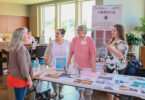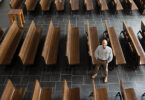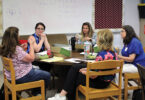by Laurie Ghigliotti
Special to The Leaven
ATCHISON — Ninety-two Benedictine Sisters from around the country gathered here at Mount St. Scholastica in late January for a conference, entitled “United in Hope,” to examine the past, present and future of monastic life in the United States.
Sisters from three federations and one congregation spent the weekend “futuring,” or looking to the future of Benedictine monastic life. (The Mount has become a sort of hub for Benedictine communities around the country, thanks to its size and the community’s ability and willingness to accommodate large numbers of visitors.)
At the same time, the participants — all under 55 years of age — considered how that future might mirror the experiences of the Benedictine women who first founded monasteries in this country, and how both might fit into the wider context of their centuries-old tradition.
Sister Bridget Dickason, one of the organizers of the conference and a member of the community at the Mount, belongs to this group of Benedictines who came of age and entered the order after Vatican II.
“We’re the future of Benedictine life, and we all want to be fostering the same Benedictine heritage, “ she said.
Three federation presidents and a congregation prioress general attended the conference. Together they expressed optimism for the future and discussed what Benedictine monasticism has to offer American society at large, in addition to its service to the community.
Sister Glenna Smith, president of the Federation of St. Scholastica, thought the communal lifestyle itself — the countercultural quality of monastic life — was a contribution.
“It seems to me that community life is the essence of Benedictine life,” she said. “We are a living model of strangers living together in peace and harmony.”
Despite dwindling numbers, all four leaders agreed that, although communities may die out, others will come into being as part of the cycle of life — in short, the Benedictine charism will live on.
“We have no fear about the sustaining of the charism,” said Sister Glenna.
Sister Ephrem Hollerman, associate professor of theology at the College of St. Benedict/St. John’s University in Minnesota, addressed the group on the topic of the history of Benedictine women in the United States. Many of the women gathered in the Dooley Center noted the similarities in their experiences with those of their predecessors.
The first Benedictine Sisters to arrive on American soil experienced a culture and a society much different from what they had known in Europe. They were forced to adapt because the stable and confined monastic model didn’t work here, said Sister Ephrem.
Those foundresses, she continued, were challenged to create a new expression of an “Old World” Benedictine tradition, just as Benedictine Sisters are being challenged to adapt to changing times today.
During small group discussions, the Sisters discussed in greater detail the challenges facing monastic communities today: logistics, culture, the perceptions of young women about religious life, and technological advances, among others.
The original mission of the Benedictine Sisters coming to America from Europe was to spread the Benedictine order and to teach immigrant children. Today, Benedictines can be found serving the community in many areas: as teachers, nurses, professors, social workers, counselors, etc.
Sister Molly Brockwell, who teaches religion at Bishop Ward High School in Kansas City, Kan., said she enjoyed the conference and the opportunity to reflect on the history and future of the order.
“In the tradition that we live — 1500 years of Benedictine tradition — we do value community and sharing everything in common,” she said. “There is such a need in our world for this witness. Our presence is so essential. We can be a light to American culture.”
Sister Molly believes that Sisters balancing their lives will always be a challenge.
“Yet, the reality is, we have to support ourselves and extend ourselves in our ministry,” she said.
Sister Elaine Fischer concurred.
“The challenge is how do we respond to the culture while still living our prayer life,” she said.
Echoing the message that Abbot Jerome Kodell of Subiaco Abbey in Arkansas once brought to the Sisters, liturgist Sister Susan Barber said, “If monasticism is to go on, we need to be mystics, in the sense that we need to be contemplatives looking for the presence of God.”
“We want women to come join us in this life from a conviction that this is a good and holy life,” said Sister Molly.
Sister Susan expressed the longing of the community to share its life with younger women. She said she treasures the fact that community life crosses generations.
“Intergenerational relationships are so rich,” she said. “We have the opportunity to live with and work with and love a variety of people.”
Sister Elaine believes that monastic life could well be different as time passes, but some things will never change.
“We will still be truly seeking God in work and prayer and with each other,” she said.
A spirit of peace about the future was evident in the women at the gathering. There was no big public relations blitz discussed — no aggressive marketing plan — to recruit young Sisters or deal with future challenges.
“We are waiting for the future,” Sister Susan said. “I was struck that we don’t need clarity. What we need is trust.”
Sisters Molly, Elaine and Barbara all voiced their gratitude for their opportunity to be part of the Benedictine community.
“One of the things that continues to amaze me is how overwhelmed I feel at how much my [fellow] Sisters love me,” Sister Molly said. “I am just bowled over by their love.”
Her personal search for God, coupled with the awareness that she could not do it alone, brought Sister Elaine to the Mount.
“My life is so much richer than what I expected,” she said.
These Sisters of Atchison’s Mount St. Scholastica, like their leaders, have no fear of the future. While there is always hope for more women to join them in their life of prayer and work, there is trust that God will continue to draw women to their community as he drew them.
When those women arrive, they will be warmly welcomed.






